All Images
News Release 04-002
Chemists Crack Secrets of Nature's Super Glue
Mussel-powered proteins stick to Teflon, even under water
This material is available primarily for archival purposes. Telephone numbers or other contact information may be out of date; please see current contact information at media contacts.
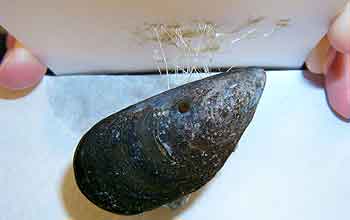
Common blue mussel (Mytilus edulis) hangs tough after a night adhering to otherwise "non-stick" Teflon®.
Credit: Jonathan Wilker of Purdue University, NSF
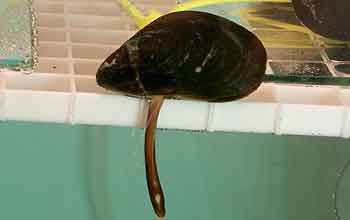
Common blue mussel (Mytilus edulis) from coastal Maine extends its foot for the camera.
Credit: Jonathan Wilker of Purdue University, NSF
Download the high-resolution TIF version of the image. (3.7 MB)
Use your mouse to right-click (Mac users may need to Ctrl-click) the link above and choose the option that will save the file or target to your computer.
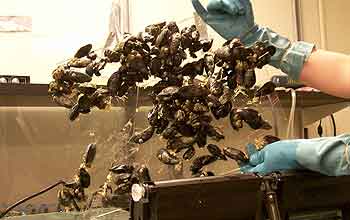
The small colony of common blue mussels adhered to this glass plate in the Wilker research laboratory in one evening.
Credit: Jonathan Wilker of Purdue University, NSF
Download the high-resolution TIF version of the image. (4.1 MB)
Use your mouse to right-click (Mac users may need to Ctrl-click) the link above and choose the option that will save the file or target to your computer.
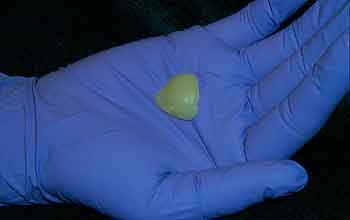
A sample of the natural glue extract before it is cured.
Credit: Jonathan Wilker of Purdue University, NSF
Download the high-resolution TIF version of the image. (3.3 MB)
Use your mouse to right-click (Mac users may need to Ctrl-click) the link above and choose the option that will save the file or target to your computer.
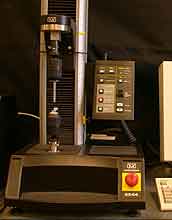
Wilker and his colleagues use an Instron Materials Testing Apparatus, or "tensile tester," to test the compressional strength of the mussel glues.
Credit: Jonathan Wilker of Purdue University, NSF
Download the high-resolution TIF version of the image. (2 MB)
Use your mouse to right-click (Mac users may need to Ctrl-click) the link above and choose the option that will save the file or target to your computer.
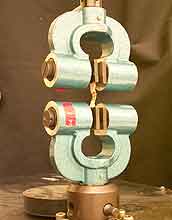
Wilker and his colleagues use the "tensile tester" and these clamps to test the ability of the glue to hold materials together when being stretched.
Credit: Jonathan Wilker of Purdue University, NSF
Download the high-resolution TIF version of the image. (1.9 MB)
Use your mouse to right-click (Mac users may need to Ctrl-click) the link above and choose the option that will save the file or target to your computer.
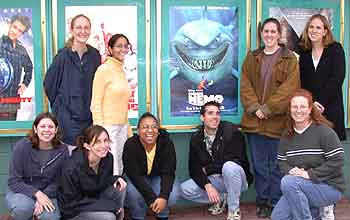
Jonathan Wilker (center) with his laboratory team: (rear left to right) Mary Sever, Mildred Rodriguez, Jennifer Monahan, Jessi Buetow; (front left to right) Jaime Weisser, Megan Lockard, Trinity Horton, Beth Hamilton.
Credit: Jonathan Wilker of Purdue University, NSF
Download the high-resolution TIF version of the image. (2.1 MB)
Use your mouse to right-click (Mac users may need to Ctrl-click) the link above and choose the option that will save the file or target to your computer.
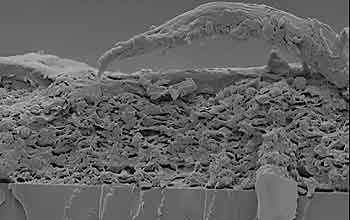
The mussel glue, or plaque, as imaged by a scanning electron microscope at a magnification of 25,000X. The glue layer (top) attaches to a glass slide.
Credit: Debby Sherman and Jonathan Wilker, Purdue University, NSF
Download the high-resolution TIF version of the image. (1.6 MB)
Use your mouse to right-click (Mac users may need to Ctrl-click) the link above and choose the option that will save the file or target to your computer.
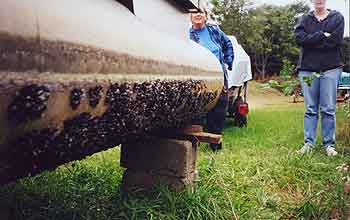
The hull of this pontoon boat is encrusted with zebra mussels. The bivalves were introduced to the United States in the 1980s, probably as stowaways in the ballast of a ship that traveled from Europe to the Great Lakes. Without natural predators, the mussels spread throughout America's waterways, infesting ships and infrastructure and competing for resources with native species. Wilker and his team are studying the properties of zebra mussel glue to find ways to prevent the animals from hitching rides on vessels.
Credit: Jonathan Wilker of Purdue University, NSF
Download the high-resolution TIF version of the image. (4.4 MB)
Use your mouse to right-click (Mac users may need to Ctrl-click) the link above and choose the option that will save the file or target to your computer.
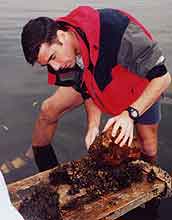
Jonathan Wilker collecting zebra mussels from a freshwater lake in northeast Indiana.
Credit: Jonathan Wilker of Purdue University, NSF
Download the high-resolution TIF version of the image. (1.6 MB)
Use your mouse to right-click (Mac users may need to Ctrl-click) the link above and choose the option that will save the file or target to your computer.
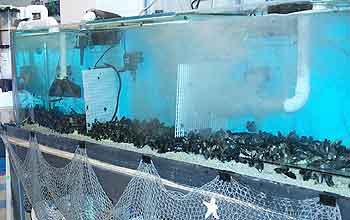
The 150-gallon tank that Wilker's more than 800 common blue mussels call home. The tank is part of a 300-gallon system that circulates water through the mussels' environment.
Credit: Jonathan Wilker of Purdue University, NSF
Download the high-resolution TIF version of the image. (1.9 MB)
Use your mouse to right-click (Mac users may need to Ctrl-click) the link above and choose the option that will save the file or target to your computer.


